Top News

March 23, 2016 Ryukyu Shimpo
Pedestrians witnessed a US soldier pointing a gun during training near the roadside around landing zone 4 in Aha, Kunigami village around 5:30 p.m. on March 20. The road leads to the village’s environmental education center, “Yanbaru Manabi no Mori,” and the soldier was aiming along the driveway that leads to prefectural road 2. The soldier was lying face-down on the roadside. According to Kunigami village, the road was built when Aha dam was constructed. The road is not a village road, and it has not been confirmed whether the road belongs to the property or the military.
Co-representative of the Takae Helipad Construction Protest Association, Masahiko Nakandakari, said, “It felt as if I was passing through training. It was frightening.” Nakandakari questioned the use of a public area for military training.
The village is notified by Okinawa Defense Bureau about the military’s training plans one week before every training, but it is not informed about the specific locations of training.
The village has received inquiries from residents about sounds of gunshots around the LZ 4 district. The bureau responded to the village, “The training is non-life fire, and they use blank shot.””
(English translation by T&CT and Sayaka Sakuma)
Go to Japanese

April 4, 2016 Ryukyu Shimpo
By Sadao Tome
Sponsored by the Okinawa Prefectural Government, exchange student 25-year-old Amy Ono studied at the Okinawa Prefectural University of Arts for one year. She is an Okinawan Nisei (second-generation immigrant), born in Los Angeles. Her study abroad days were filled with Ryukyu Buyo, Shamisen, and Kumi Odori. Amy’s lifestyle changed dramatically from a work-centered life in the United States to one immersed in the Ryukyu performing arts.
There are two events during Ono’s study abroad, which she says stand out in her memory: participating in the Friendship Camp hosted by Hyogo and Okinawa Prefectures, as well as performing in “Ayamiya no Utage,” an Okinawan historical musical.
Ono met Minami Tamamoto for the first time in the Second World Youth Uchinanchu Festival held in Los Angeles in 2013. Twenty eight-year old Tamamoto is president of the World Youth Uchinanchu Association (WYUA) and has been crowned Miss Uruma. The two reunited when Ono came back to Okinawa as an exchange student. Ryukyu Buyo connected the two together. The two dancers collaborated for the first time in a classical Yotsudake (four bamboo pieces) Dance. Tamamoto reflected, “We first met across the ocean and now we are here in our hometown of Okinawa, dancing Ryukyu Buyo. I am thrilled to think how this has brought us closer.”
Professor Eikichi Hateruma, who instructed Ono, says of his student, “She always came in with a positive attitude and gave well thought-out answers to my questions. I could tell that she really absorbed everything that she could from her Buyo practices as well. At the end of last year, she took part in the ‘Free Campus University’ hosted by Taketomi Island and Kohama Island and entertained the locals there. I’m sure it was meaningful for her to have explored the small islands of Yaeyama.”
Ono says she is forever grateful to the supportive members of the Okinawan Association of America, her family, all of the international students that she met in Okinawa, her classmates, and everyone she has encountered through various performances and events. She does not take it for granted that she has been able to reunite with them. “My experiences have inspired me to teach Buyo in the U.S. in the future. For this reason, I would like to stay in Okinawa for another year to stay involved in the Ryukyu performing arts scene.”
(Translation by T&CT, Kaya Doi)
Go to Japanese
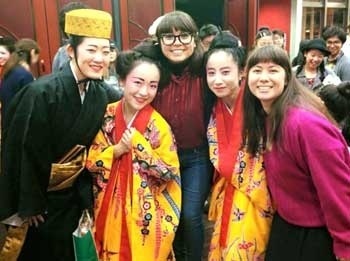
Amy Ono (far left) and Minami Tamamoto (fourth from left) pose together with their international friends from Argentina and Peru, on the day of their performance of “Ayamiya no Utage” on March 12.
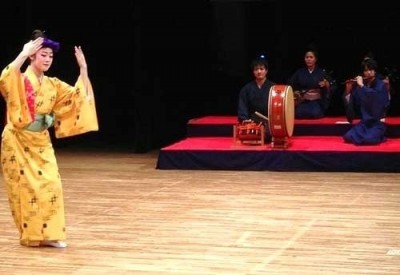
Amy Ono (left) dances in a Kanayo performance at an Okinawan Arts Festival held at the Okinawa Prefectural University of Arts on November 2, 2015.

April 5, 2016 Ryukyu Shimpo
In the United States, film director Reggie Life has made a movie version of author Tatsuhiro Oshiro’s 1965 novel Cocktail Party, the first literary work from Okinawa to win the Akutagawa Prize in 1967.
In 1995, Oshiro made a play version of the book set in 1971. Katsunori Yamazato, the president of Meio University, made an English translation of the play that was performed in Hawaii in 2011. Life has been working on making Cocktail Party into a movie since 2005, filming primarily in the United States.
Upon the film’s completion, Oshiro praised Life on his tenacity as a director in his 10 plus years of work on the movie. He went on to say the final product is a collaborative work between Life, Yamazato, and himself. His hope is that, “people all over the world will come to know about Okinawa’s unresolved base issues.” Yamazato mentioned that he wants viewers to consider the film and the original book as separate works, because they have added recent occurrences to the movie.
Since the time that Cocktail Party won the Akutagawa Prize, three more literary works from Okinawa have won. These are An Okinawan Boy by Mineo Higashi, The Pig’s Retribution by Eiki Matayoshi, and The Crying Wind by Shun Medoruma. These works also have film versions directed by Taku Shinjo, Yoichi Sai, and Yoichi Higashi, respectively.
(English translation by T&CT and Erin Jones)
Go to Japanese
April 4, 2016 Ryukyu Shimpo
The detention of Shun Medoruma was an act of illegitimate confinement on the part of the United States military with the aim of using brute force to suppress freedom of thought, belief, and expression. We must not tolerate pressure that antagonizes Okinawan opposition to the new base construction. The perpetrators of this illegitimate act must realize that resistance from Okinawan society will only grow stronger.
Akutagawa Prize-winning author Shun Medoruma, age 55, was released after being arrested following capture in the ocean near Camp Schwab for allegedly having entered into the U.S. military-controlled area of the waters. He was arrested at the 11th Region Headquarters of the Japan Coast Guard on suspicion of having violated the Special Criminal Law, a law based on the U.S.-Japan security treaty. Thirty-four hours passed from the time of his capture by a U.S. military guard until the time of his release.
Medoruma was engaging in protest at sea to oppose the construction of a new U.S. military base in Henoko, Nago. He serves as a symbol of Okinawan opposition to the new base.
His release was a matter of course, yet it hardly puts an end to the incident.
While Medoruma and his colleagues were engaging in their usual protest activities at sea, several U.S. security guards were filming them from land. This was clearly unusual. The guard who captured Medoruma is said to have called out Medoruma’s real name during the arrest. There is a high likelihood that Medoruma was targeted as an individual.
Furthermore, Medoruma was held captive inside Camp Schwab for eight hours before being turned over to the Japan Coast Guard. He was not allowed to see a lawyer during that time. This was a severe violation of human rights.
Medoruma’s lawyer criticized the U.S. military and involved investigation agencies for their behavior, saying, “This is illegitimate suppression of the protest movement. [Medoruma’s] lengthy detainment constitutes illegal confinement.”
After Medoruma’s capture, his lawyer contacted the Okinawa Defense Bureau, the Okinawa prefectural police, and the Coast Guard regarding his whereabouts, but could not obtain a clear response. It is highly abnormal that Japanese government agencies are unable to confirm the location and status of one of their own citizens who has been robbed of his freedom inside a U.S. base, outside the purview of Japanese sovereignty. As a result, the Japanese government can be seen as complicit in the loss of sovereignty and human rights violation signified by Medoruma’s lengthy detainment.
After the recent court settlement between Okinawa and the national government, the government lost the authority to continue construction on the new base. Despite the suspension of construction, the U.S. and Japanese governments have maintained the “temporary restricted area” established in the bay to facilitate construction.
The legal legitimacy of keeping this area of the bay off-limits is questionable to begin with. There is no justification for arresting a Japanese citizen with no intention of trespassing inside the U.S. base or obstructing base operations, and who has caused no real damage to either Japan or the United States. Perhaps the U.S. military’s act of force was the result of irritation at the suspension of construction of the new base.
We are obligated to question this act by the U.S. and Japanese governments. We must clarify the legal issues involved, and put a stop to illegitimate security measures implemented with the political aim of suppressing civic resistance to the new base.
(English translation by T&CT and Sandi Aritza)
Go to Japanese
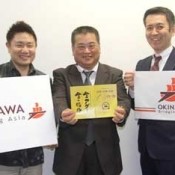
March 29, 2016 Ryukyu Shimpo
Kin Agu Corporation shipped its first Okinawan agu pork to Singapore. Meat products totaling 456 kg per month will be sold at local high class restaurants and stores. According to the prefecture, this will be the first import of Okinawan agu to Singapore.
All the pork meats need to be processed in facilities licensed for import approval when they are carried abroad. Since there are no facilities licensed to process meat for export to Singapore in Okinawa, the meat will be processed at facilities in Kagoshima Prefecture. After processing, the meat will be shipped by air from the Naha airport using the prefectural government’s international logistics hub promotion project.
Kin Agu plans to increase the amount of agu monthly imported from 40 pigs to 100 pigs within two years as it pushes to expand its market abroad. The company is also considering starting pork exports to Taiwan by the end of this year. Mitsumori Kokuba, the president of the company, who visited Ryukyu Shimpo on March 28 said, “We want to sell good meat produced in the prefecture, and we want people who eat agu to visit Okinawa.”
According to Katsuya Tamaki of Singapore branch office of the Okinawa Prefectural Government, pork meat produced in Japan is getting popular and agu can be sold at high prices as a premium brand.
(English translation by T&CT and Sayaka Sakuma)
Go to Japanese
March 30, 2016 Ryukyu Shimpo
On March 29, the Okinawa Distillers Association announced figures of shipments of Awamori for the fiscal year of 2015. The total of shipments was 19,247 kiloliters, down 3.9% on the previous year, and the first figure under 20,000 kiloliters in 16 years. Shipments of Awamori declined 30.5 percent to 27,688 kiloliters in the 11th consecutive year of decline from the peak in 2004. Despite the Association doing PR presentations and projects using funding from the Prefecture, the decline of shipments does not stop.
While shipments within the prefecture totaled 16,368 kiloliters, 76.3 percent of the peak, shipments to other prefectures dropped to 2879 kiloliters, only 30.5 percent of the peak. At the press meeting, Yoshihide Matayoshi, the executive of the Association, explained, “The brewing industry tried hard to increase shipments, but we have not seen a result. We take this situation as a serious crisis.”
Possible reasons for the decline lie in youth’s disinterest in alcohol, population decline, and a public push to eradicate drunk driving. The Association has launched a policy to strengthen sales in three areas: 1) transmitting attractive information of old vintage Awamori; 2) developing low alcohol products for women and youth; 3) selling products in a way that attracts tourists.
Chairman of the Association Tamanaha said, “We need to enrich this local industry bearing in mind culture and tradition.”
(English translation by T&CT and Megumi Chibana)
Go to Japanese

March 30, 2016 Ryukyu Shimpo
On March 26, British cruise ship Queen Elizabeth docked at Naha Cruise Terminal, its first visit to Okinawa. The Okinawa Sake Brewers Association and the Okinawa Regional Taxation Office, the governing agency of Awamori, held a tasting event to showcase Okinawan aged sakes to expand demand for Awamori.
Consumption of the liquor has decreased lately. Awamori Queen Miyu Oshiro and its office staff highlighted the charms of the alcoholic beverage to visitors from overseas.
The organizers offered samples of aged sakes with alcohol content of 43 percent and 25 percent to the tourists. They tasted these two types of sakes, inquiring about the ingredients used in the beverages. The organizers handed out about 1,000 English brochures about Awamori.
An office representative said, “We would like to promote Awamori in order to increase its demand.
(English translation by T&CT)
Go to Japanese
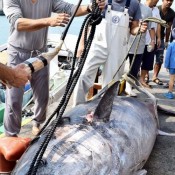
March 31, 2016 Ryukyu Shimpo
On March 30, a 413 kilogram-bluefin tuna measuring about 2.6 meters was landed at Ishigaki Fishing Port. With a large population of tuna, Ishigaki is one of the foremost fishing ports in Okinawa. Hiroyuki Tanaka, the captain of Tenshinmaru, said it took five hours to catch the tuna. He added, “I was surprised. I am now relieved to have caught the tuna.”
The Bluefin tuna was caught in the water about 55 kilometers south of Ishigaki Island. A representative of Yaeyama Fishermen’s Cooperative said, “While it is not easy to compare all the tunas that have been landed at the port, I think it is the biggest one.”
(English translation by T&CT)
Go to Japanese
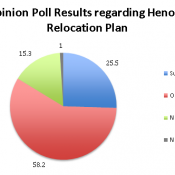
April 1, 2016 Ryukyu Shimpo
The Okinawa Prefectural Government carried out an opinion poll among Okinawan citizens in 2015 relating to regional security. One question asked was “Do you support or oppose the Japanese government’s plan to relocate Futenma Air Station to Henoko in Nago City?” In answer, 58.2 percent said they oppose it, and 25.5 percent said they support it, less than half in comparison to those who oppose. Another question was “Can you accept Futenma Air Station remaining in place?” The answer was overwhelmingly “I cannot accept it” at 68.6 percent, in comparison to only 6.7 percent who answered, “I can accept it.” These numbers show strong popular will opposing both the Henoko relocation plan and Futenma Air Station remaining in place.
For the first time in 2015, levels of certainty within support or opposition were specified on this opinion poll.
In total 25.5 percent of respondents said they support the plan. The answer “I support the plan” accounted for 13.5 percent, and “If I had to say one way or the other I would say I support the plan” accounted for 12 percent. Out of the 58.2 percent of respondents who oppose the plan, 44.6 percent said, “I oppose the plan” outright, and 13.6 percent said, “If I had to say one way or the other I would say I oppose the plan.” The remaining respondents said they were not sure at 15.3 percent, and 1 percent did not answer the question at all.
Out of respondents to “Can you accept Futenma Air Station remaining in place?” 23.3 percent said they were not sure, and 1.4 percent did not respond.
Both the 2014 and 2015 versions of this opinion poll asked if US Forces, Japan (USFJ) has a positive or negative image, including the “If I had to say one way or the other” wording. In 2014 32.8 percent of respondents said the USFJ has a positive image, and 45.6 said it had a negative one. In 2015, 28.3 percent responded that the USFJ has a positive image, and 53.8 percent reported a negative image. That marks an 8.2 percentage point increase in the negative image from the year prior.
The questionnaire document was sent to 3000 men and women between the ages of 15 and 74. Of those who received it 1265 people answered it, at a 42.2 percent response rate.
(English translation by T&CT and Erin Jones)
Go to Japanese
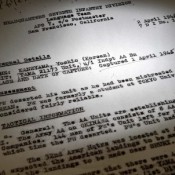
April 1, 2016 Ryukyu Shimpo
By Hideki Matsudo
U.S. forces landed on Okinawa Island on April 1, 1945, marking the start of the Battle of Okinawa. On March 31, 2016, Ryukyu Shimpo obtained a written record of testimony made by a Japanese soldier of Korean descent who had been captured by U.S. troops in Okinawa on the day that they landed. It appears that the Korean soldier was the first prisoner of war captured by U.S. forces on Okinawa Island. The document in question was found at the U.S. National Archives. The Korean soldier told his questioners that he had fled due to unbearable abuse he received in his unit, and that the Japanese troops had headed toward Shuri on March 25, seven days before the U.S. landing. His testimony is consistent with records of Japanese military actions compiled after the war. The document also shows that the U.S. troops gained an accurate understanding of the Japanese military’s movements by questioning prisoners of war starting on the very day they landed on Okinawa Island.
While there were likely more than ten thousand Korean nationals conscripted to fight in the Battle of Okinawa, there is hardly any first-hand testimony about them, and details remain unknown. Okinawa International University professor emeritus and scholar of the Battle of Okinawa Masaie Ishihara says it is very rare to find evidence of activity or testimony by Korean nationals mobilized to fight in the Battle of Okinawa.
The record of the soldier’s testimony is one page long. It states the prisoner’s name as “’Kaneyama Yoshio’ (Korean)” and says he belonged to the 80th Field Antiaircraft Artillery Battalion under the 32nd Army command. According to the document, Kaneyama had been a student at Tokyo Imperial University.
The testimony was recorded by an American officer on the language team of the 7th Infantry Division that landed on Okinawa on April 1. It says that Kaneyama had left his unit on March 25, 1945, seven days before he was captured. The reason he gave for fleeing was that he had been treated badly in the unit due to being of Korean descent.
The record also includes information about Japanese military strategy, including information that the Antiaircraft Artillery Battalion was building an encampment near Shuri. This shows that the U.S. military had information that the Japanese military would be centered near Shuri.
The document also lists as secondhand information the prisoner reported having heard that four divisions were deployed on Okinawa Island, including the Yama unit, Take unit, and Tama unit. The U.S. military appears to have been gathering important military information from the prisoner in order to plan its own military strategy.
The testimony also includes details about the movement of civilians. It says that all men were conscripted for military-related work, and all other civilians were sent to the northern part of Okinawa Island while the Japanese troops made their way to the southern part of the island.
(English translation by T&CT and Sandi Aritza)
Go to japanese
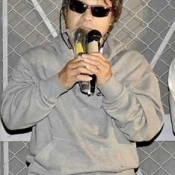
April 3, 2016 Ryukyu Shimpo
On April 2, the Japan Coast Guard (JCG) referred Akutagawa Prize winning novelist Shun Medoruma, 55, to the Naha prosecutor’s office. The novelist was arrested on March 1 on suspicion of violating the Act on Special Measures Concerning Criminal Cases for entering the restricted area beside U.S. Marine Corps Camp Schwab from off the coast of Henoko, Nago.
At 7:15 p.m. on April 2, the prosecutor’s office released him without having decided whether it will indict him or drop the case. Medoruma said, referring to his arrest, “It was an extraordinary situation because I had no intention to intrude [on the restricted area]. I was only trying to pass through.”
On April 1, he was protesting against the construction of the new U.S. base, handling a canoe off the coast of Henoko.
At 9:20, a Japanese security guard employed by U.S. Marine Corps detained Medoruma, alleging that he entered the restricted area.
He was taken into confinement for about eight hours within the U.S. base.
At 5:22 p.m., he was turned over to the Japan’s Coast Guard Office in Okinawa City.
(English translation by T&CT)
Go to Japanese











 Webcam(Kokusai Street)
Webcam(Kokusai Street)


